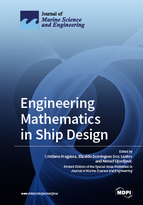Engineering Mathematics in Ship Design
A special issue of Journal of Marine Science and Engineering (ISSN 2077-1312). This special issue belongs to the section "Ocean Engineering".
Deadline for manuscript submissions: closed (25 January 2019) | Viewed by 44006
Special Issue Editors
Interests: mechanical engineering; advanced materials; materials engineering; structural analysis; composite material; mechanical design; manufacturing engineering; quality in industry
Special Issues, Collections and Topics in MDPI journals
Interests: fluid mechanics; heat transfer; design; renewable energy; computational fluid dynamics
Special Issues, Collections and Topics in MDPI journals
Interests: applied and computational mechanics; dynamic analysis of solids and structures; thermodynamic constitutive models; plasticity and damage; anisotropic materials
Special Issues, Collections and Topics in MDPI journals
Special Issue Information
Dear Colleagues,
Engineering mathematics is a branch of applied mathematics where mathematical methods and techniques are implemented for solving problems related to the engineering and industry. It also represents a multidisciplinary approach where theoretical and practical aspects are deeply merged with the aim at obtaining optimized solutions. In line with that, the present Special Issue, 'Engineering Mathematics in Ship Design', is focused, in particular, with the use of this sort of engineering science in the design of ships and vessels. Articles are welcome when applied science or computation science in ship design represent the core of the discussion.
Dr. Cristiano Fragassa
Dr. Elizaldo Domingues dos Santos
Dr. Nenad Djordjevic
Guest Editors
Manuscript Submission Information
Manuscripts should be submitted online at www.mdpi.com by registering and logging in to this website. Once you are registered, click here to go to the submission form. Manuscripts can be submitted until the deadline. All submissions that pass pre-check are peer-reviewed. Accepted papers will be published continuously in the journal (as soon as accepted) and will be listed together on the special issue website. Research articles, review articles as well as short communications are invited. For planned papers, a title and short abstract (about 100 words) can be sent to the Editorial Office for announcement on this website.
Submitted manuscripts should not have been published previously, nor be under consideration for publication elsewhere (except conference proceedings papers). All manuscripts are thoroughly refereed through a single-blind peer-review process. A guide for authors and other relevant information for submission of manuscripts is available on the Instructions for Authors page. Journal of Marine Science and Engineering is an international peer-reviewed open access monthly journal published by MDPI.
Please visit the Instructions for Authors page before submitting a manuscript. The Article Processing Charge (APC) for publication in this open access journal is 2600 CHF (Swiss Francs). Submitted papers should be well formatted and use good English. Authors may use MDPI's English editing service prior to publication or during author revisions.
Keywords
- Naval Engineering
- Ship Design Process
- Ship Motion, Flotation and Stability
- Structural Analysis
- Hydrostatic and, Hydrodynamics
- Marine Propulsion
- Shipbuilding
- Applied Analysis
- Mathematical Models, Methods and Techniques
- Computational Engineering








